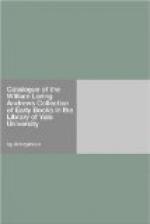Title: Catalogue of the William Loring Andrews Collection of Early Books in the Library of Yale University
Author: Anonymous
Release Date: October 9, 2005 [EBook #16844]
Language: English
Character set encoding: ASCII
*** Start of this project gutenberg EBOOK catalogue of early books ***
Produced by Internet Archive/Canadian Libraries (http://www.archive.org/details/toronto), Jason Isbell, Julia Miller and the Online Distributed Proofreading Team at http://www.pgdp.net
Transcriber’s Note: This book has a number of characters which cannot be represented in a text format. The following coding has been used for these characters.
[upturned A] A printed upside down [=e] e with macron [oe] oe ligature
Inconsistencies in hyphenation and spelling found in the original book have been retained in this version. A list of these inconsistencies is found at the end of the text.
Catalogue of early printed books
Catalogue
Of the
William Loring Andrews
Collection of early books
In the
Library of Yale University
[Printer’s Seal]
New Haven: Yale
University press
London: Humphrey Milford
Oxford University press
MCMXIII
Copyright, 1913
by
Yale University press
Printed from type October, 1913. 300 copies
PREFACE
The collection of early printed books presented to the Library of Yale University in 1894 by Mr. William Loring Andrews, of New York, was formed to illustrate the first century of printing, which is a better boundary for the survey than the half-century ending with the year 1500, more often chosen. The latter, the so-styled cradle period of the art, is wanting in real definition, being at most a convenient halting place, not a completed stage, whereas at the middle of the sixteenth century the printed book of the better class had acquired most of its maturer features and no longer has for us an unfamiliar look. Designed to serve as a permanent exhibition, it is a selection rather than a collection, not large, but wisely chosen, and no less attractive than instructive, having been formed a quarter of a century ago, at a time when opportunities were unusually favorable.
The surviving books of the first presses, which are the chief sources of our knowledge of the early art, are at the same time, when obtainable, the most efficient teachers. For the illustration of the typography, the feature of first importance, there is nothing comparable to the open pages of a representative series of the original books, such as are here spread out before us. The best of the available substitutes, phototype reproductions of specimen pages, apart from other limitations, must always lack the authority and the impressiveness of the originals.




